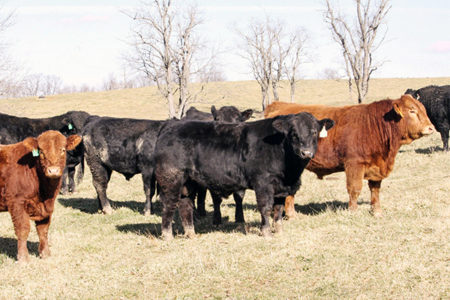Managing Your Bull’s Fertility

Many factors can affect sperm production, but four of the main factors that can decrease sperm production are injury, disease, fever, and extreme environmental conditions.
by George Perry
Professor & SDSU Extension Beef Reproductive Management Specialist
SDSU Animal Science Department
As winter has hung around longer than normal this year, it is important to be thinking about your herd bulls. Many factors can affect sperm production, but four of the main factors that can decrease sperm production are injury, disease, fever, and extreme environmental conditions.
Spermatogenesis, the production of sperm, is a 61 day process in bulls; thus, it takes 61 days following complete recovery of an insult/injury to have normal sperm again. This is important to realize if a bull experiences frost bite, or any other injury to his scrotum/testis. It will be 2 months before he is completely recovered. Injury to the penis or testis during the winter can also result in infertility in bulls.
Breeding Soundness Examination
The American Society for Theriogenology has developed minimum guidelines for a bull to pass a breeding soundness evaluation A breeding soundness evaluation includes a physical examination, the measurement of scrotal circumference, and an evaluation of semen quality. To successfully complete a breeding soundness evaluation, a bull must have at least 30% sperm motility, 70% normal sperm morphology, and a minimum scrotal circumference based on age (Chenoweth et al. 1992).
Bulls meeting the preceding minimum requirements are classified as satisfactory potential breeders. If a bull does not pass one of these tests, he is either classified as a classification deferred (meaning it is recommended that the bull be tested again) or as an unsatisfactory potential breeder. Bulls should be tested approximately 6 to 4 weeks prior to the breeding season. This time period allows for time to either retest bulls when unsatisfactory results are obtained or to find a replacement herd bull.
Physical Examination
The physical examination portion of a BSE determines a bull’s physical capabilities needed to successfully breed a cow. A bull must be able to see, smell, eat, and move normally to successfully breed cows.
Scrotal Circumference
Scrotal circumference tells us testicular mass and as it increases, so does the daily production of high-quality sperm.
Semen Quality
Semen quality includes ejaculate volume, sperm cell motility, and sperm cell morphology. Sperm motility is evaluating the percentage of spermatozoa in an ejaculate that has progressive (headfirst) movement. Sperm morphology is calculated by evaluating the percentages of normal spermatozoa and sperm with abnormalities, and sperm morphology can have lager impacts on pregnancy success.
Bulls with less than 20% abnormal sperm had greater pregnancy rates compared to other bulls (Wiltbank and Parish 1986). Therefore, selection of bulls with greater than normal sperm can increase overall pregnancy rates in a herd. It is important to remember that substandard nutrition, extreme environmental temperatures, and disease can reduce semen quality, and the quality of semen from a single bull may change over time.
Other Considerations
There are also factors that are not evaluated in a BSE that can impact bull fertility. Libido refers to the desire to mate, and has positive effects on pregnancy rates. For this reason it is important to evaluate a bull’s desire to mate prior to the start of breeding season. Libido can practically be evaluated by closely watching a bull after introducing him to a cow herd, is his interest in detecting cows in estrus, or in finding a feedbunk?
Differences in serving capacity also exists between bulls just as their desire to mate (libido) varies. Recommendations for bull-to-cow ratios range from 1:10 up to 1:60.
Yearling bulls have a lower serving capacity than older bulls. Therefore, it is important to remember that young bulls should be utilized at a lower bull-to-cow ratio than older bulls, but how many cows can one bull cover? No differences were detected between a bull to female ratio of 1:25 and 1:60 for estrous detection or pregnancy rates in the first 21 days of the breeding season, provided the bulls were mature, highly fertile, and had large scrotal circumferences (Rupp et al. 1977).
Remember, since the estrous cycle in cows is approximately 20 days, in a group of non-synchronized cows a ratio of 1:40 means the bull only has to breed 2 cows per day on average.
The Bottom Line
We need to remember that a BSE is not good for life, and that it takes approximately 2 months for a bull to recover from any insult/injury to his scrotum/testis. Even when a bull has good semen quality we should be observing libido and mating ability periodically during the breeding season. Keeping these things in mind and planning ahead for the breeding season will result in a success breeding season.



